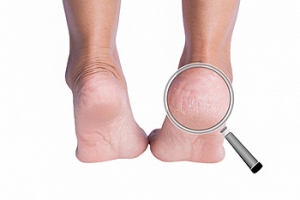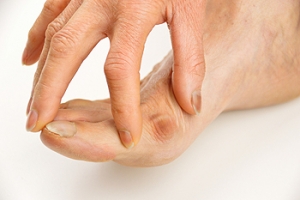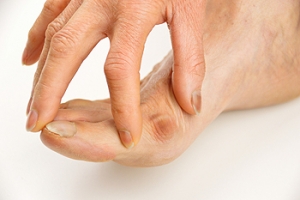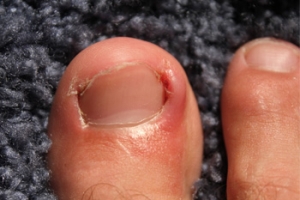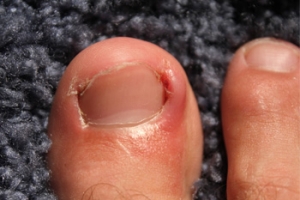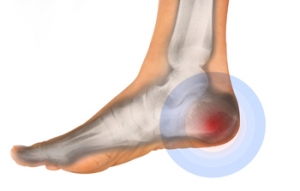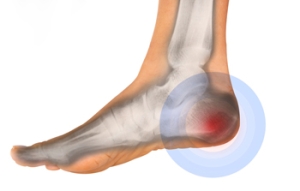Items filtered by date: December 2018
Possible Causes of Cracked Heels
If you suffer from cracked heels, you may be familiar with the pain and discomfort that is often associated with this condition. There are several reasons linked to developing cracked heels, including a loss of moisture in the skin as the aging process occurs, and medical conditions that may include thyroid issues and vitamin deficiencies. Additionally, people who are obese may suffer from this condition and this may be a result of the excess weight the heels must endure. Research has shown the importance of wearing shoes that offer maximum support in the heel area, which may diminish the possibility of developing this painful condition. There may be measures that can be implemented to prevent this ailment from occurring, which may include washing and drying the feet thoroughly, followed by utilizing a good moisturizing cream. If you have cracked heels, it is suggested to speak to a podiatrist to discuss additional treatment options.
If the skin on your feet starts to crack, you may want to see a podiatrist to find treatment. If you have any concerns, contact Dr. Kenneth Donovan from Advanced Care Foot and Ankle. Our doctor can provide the care you need to keep you pain-free and on your feet.
Cracked Heels
It is important to moisturize your cracked heels in order to prevent pain, bleeding, and infection. The reason cracked heels form is because the skin on the foot is too dry to support the immense pressure placed on them. When the foot expands, the dry skin on the foot begins to split.
Ways to Help Heal Them
- Invest in a good foot cream
- Try Using Petroleum Jelly
- Ease up on Soaps
- Drink Plenty of Water
Ways to Prevent Cracked Heels
- Moisturize After Showering
- Skip a Shower
- Keep Shower Water Lukewarm
- Don’t Scrub Your Feet
If you are unsure how to proceed in treating cracked heels, seek guidance from a podiatrist.
Your doctor will help you with any questions or information you may need.
If you have any questions, please feel free to contact one of our offices located in Warren, Livingston, and Toms River, NJ. We offer the newest diagnostic and treatment technologies for all your foot care needs.
Corns and Bunions May Produce Foot Pain
There are many types of foot conditions that may cause considerable pain and discomfort, which can lead to limited mobility. The foot is comprised of several bones, tendons and ligaments and if any one of these should endure an injury, the overall function of the body may be compromised. There are several types of foot pain most of the population may experience at some point in their lives. These may include having a corn develop, which is a small and yellowish area that generally forms on the top of the toes. This is typically the result of wearing shoes that fit incorrectly. Additionally, a bony protrusion that forms on the side of the big toe is referred to as a bunion and may develop from having arthritis or wearing improper footwear. If a fall has occurred, spraining or breaking the ankle may be a painful consequence. If you are experiencing any type of foot pain, it is advised to seek the counsel of a podiatrist who can properly treat these conditions.
Foot Pain
Foot pain can be extremely painful and debilitating. If you have a foot pain, consult with Dr. Kenneth Donovan from Advanced Care Foot and Ankle. Our doctor will assess your condition and provide you with quality foot and ankle treatment.
Causes
Foot pain is a very broad condition that could be caused by one or more ailments. The most common include:
- Bunions
- Hammertoes
- Plantar Fasciitis
- Bone Spurs
- Corns
- Tarsal Tunnel Syndrome
- Ingrown Toenails
- Arthritis (such as Gout, Rheumatoid, and Osteoarthritis)
- Flat Feet
- Injury (from stress fractures, broken toe, foot, ankle, Achilles tendon ruptures, and sprains)
- And more
Diagnosis
To figure out the cause of foot pain, podiatrists utilize several different methods. This can range from simple visual inspections and sensation tests to X-rays and MRI scans. Prior medical history, family medical history, and any recent physical traumatic events will all be taken into consideration for a proper diagnosis.
Treatment
Treatment depends upon the cause of the foot pain. Whether it is resting, staying off the foot, or having surgery; podiatrists have a number of treatment options available for foot pain.
If you have any questions, please feel free to contact one of our offices located in Warren, Livingston, and Toms River, NJ . We offer the newest diagnostic and treatment technologies for all your foot care needs.
Corns and Bunions May Produce Foot Pain
 There are many types of foot conditions that may cause considerable pain and discomfort, which can lead to limited mobility. The foot is comprised of several bones, tendons and ligaments and if any one of these should endure an injury, the overall function of the body may be compromised. There are several types of foot pain most of the population may experience at some point in their lives. These may include having a corn develop, which is a small and yellowish area that generally forms on the top of the toes. This is typically the result of wearing shoes that fit incorrectly. Additionally, a bony protrusion that forms on the side of the big toe is referred to as a bunion and may develop from having arthritis or wearing improper footwear. If a fall has occurred, spraining or breaking the ankle may be a painful consequence. If you are experiencing any type of foot pain, it is advised to seek the counsel of a podiatrist who can properly treat these conditions.
There are many types of foot conditions that may cause considerable pain and discomfort, which can lead to limited mobility. The foot is comprised of several bones, tendons and ligaments and if any one of these should endure an injury, the overall function of the body may be compromised. There are several types of foot pain most of the population may experience at some point in their lives. These may include having a corn develop, which is a small and yellowish area that generally forms on the top of the toes. This is typically the result of wearing shoes that fit incorrectly. Additionally, a bony protrusion that forms on the side of the big toe is referred to as a bunion and may develop from having arthritis or wearing improper footwear. If a fall has occurred, spraining or breaking the ankle may be a painful consequence. If you are experiencing any type of foot pain, it is advised to seek the counsel of a podiatrist who can properly treat these conditions.
Foot Pain
Foot pain can be extremely painful and debilitating. If you have a foot pain, consult with Dr. Kenneth Donovan from Advanced Care Foot and Ankle. Our doctor will assess your condition and provide you with quality foot and ankle treatment.
Causes
Foot pain is a very broad condition that could be caused by one or more ailments. The most common include:
- Bunions
- Hammertoes
- Plantar Fasciitis
- Bone Spurs
- Corns
- Tarsal Tunnel Syndrome
- Ingrown Toenails
- Arthritis (such as Gout, Rheumatoid, and Osteoarthritis)
- Flat Feet
- Injury (from stress fractures, broken toe, foot, ankle, Achilles tendon ruptures, and sprains)
- And more
Diagnosis
To figure out the cause of foot pain, podiatrists utilize several different methods. This can range from simple visual inspections and sensation tests to X-rays and MRI scans. Prior medical history, family medical history, and any recent physical traumatic events will all be taken into consideration for a proper diagnosis.
Treatment
Treatment depends upon the cause of the foot pain. Whether it is resting, staying off the foot, or having surgery; podiatrists have a number of treatment options available for foot pain.
If you have any questions, please feel free to contact one of our offices located in Warren, Livingston, and Toms River, NJ . We offer the newest diagnostic and treatment technologies for all your foot care needs.
Read more about Foot PainSymptoms of an Ingrown Toenail
The definition of an ingrown toenail is described as the toenail growing into a portion of the skin on either side of the nail. This condition may cause little discomfort in the early stages of development and may worsen as time progresses. Swelling, redness, or a possible infection may occur as a result of the nail piercing the skin, and this may lead to an infection. The body’s natural response for healing is to have a specific type of skin that may grow at the site of the infection, which is known as hypergranulation. This will generally dissolve once treatment has begun and the infection dissipates. There are several causes for this ailment to occur, and these may include wearing poorly fitting shoes or socks, having a family history of ingrown toenails, or improperly trimming the toenails. If you feel you have developed this uncomfortable condition, it is suggested to seek the advice of a podiatrist who can properly assist in the correct treatment.
Ingrown toenails can become painful if they are not treated properly. For more information about ingrown toenails, contact Dr. Kenneth Donovan of Advanced Care Foot and Ankle. Our doctor can provide the care you need to keep you pain-free and on your feet.
Ingrown Toenails
Ingrown toenails occur when a toenail grows sideways into the bed of the nail, causing pain, swelling, and possibly infection.
Causes
- Bacterial infections
- Improper nail cutting such as cutting it too short or not straight across
- Trauma to the toe, such as stubbing, which causes the nail to grow back irregularly
- Ill-fitting shoes that bunch the toes too close together
- Genetic predisposition
Prevention
Because ingrown toenails are not something found outside of shoe-wearing cultures, going barefoot as often as possible will decrease the likeliness of developing ingrown toenails. Wearing proper fitting shoes and using proper cutting techniques will also help decrease your risk of developing ingrown toenails.
Treatment
Ingrown toenails are a very treatable foot condition. In minor cases, soaking the affected area in salt or antibacterial soaps will not only help with the ingrown nail itself, but also help prevent any infections from occurring. In more severe cases, surgery is an option. In either case, speaking to your podiatrist about this condition will help you get a better understanding of specific treatment options that are right for you.
If you have any questions please feel free to contact one of our offices located in Warren, Livingston, and Toms River, NJ. We offer the newest diagnostic and treatment technologies for all your foot and ankle needs.
Symptoms of an Ingrown Toenail
 The definition of an ingrown toenail is described as the toenail growing into a portion of the skin on either side of the nail. This condition may cause little discomfort in the early stages of development and may worsen as time progresses. Swelling, redness, or a possible infection may occur as a result of the nail piercing the skin, and this may lead to an infection. The body’s natural response for healing is to have a specific type of skin that may grow at the site of the infection, which is known as hypergranulation. This will generally dissolve once treatment has begun and the infection dissipates. There are several causes for this ailment to occur, and these may include wearing poorly fitting shoes or socks, having a family history of ingrown toenails, or improperly trimming the toenails. If you feel you have developed this uncomfortable condition, it is suggested to seek the advice of a podiatrist who can properly assist in the correct treatment.
The definition of an ingrown toenail is described as the toenail growing into a portion of the skin on either side of the nail. This condition may cause little discomfort in the early stages of development and may worsen as time progresses. Swelling, redness, or a possible infection may occur as a result of the nail piercing the skin, and this may lead to an infection. The body’s natural response for healing is to have a specific type of skin that may grow at the site of the infection, which is known as hypergranulation. This will generally dissolve once treatment has begun and the infection dissipates. There are several causes for this ailment to occur, and these may include wearing poorly fitting shoes or socks, having a family history of ingrown toenails, or improperly trimming the toenails. If you feel you have developed this uncomfortable condition, it is suggested to seek the advice of a podiatrist who can properly assist in the correct treatment.
Ingrown toenails can become painful if they are not treated properly. For more information about ingrown toenails, contact Dr. Kenneth Donovan of Advanced Care Foot and Ankle. Our doctor can provide the care you need to keep you pain-free and on your feet.
Ingrown Toenails
Ingrown toenails occur when a toenail grows sideways into the bed of the nail, causing pain, swelling, and possibly infection.
Causes
- Bacterial infections
- Improper nail cutting such as cutting it too short or not straight across
- Trauma to the toe, such as stubbing, which causes the nail to grow back irregularly
- Ill-fitting shoes that bunch the toes too close together
- Genetic predisposition
Prevention
Because ingrown toenails are not something found outside of shoe-wearing cultures, going barefoot as often as possible will decrease the likeliness of developing ingrown toenails. Wearing proper fitting shoes and using proper cutting techniques will also help decrease your risk of developing ingrown toenails.
Treatment
Ingrown toenails are a very treatable foot condition. In minor cases, soaking the affected area in salt or antibacterial soaps will not only help with the ingrown nail itself, but also help prevent any infections from occurring. In more severe cases, surgery is an option. In either case, speaking to your podiatrist about this condition will help you get a better understanding of specific treatment options that are right for you.
If you have any questions please feel free to contact one of our offices located in Warren, Livingston, and Toms River, NJ . We offer the newest diagnostic and treatment technologies for all your foot and ankle needs.
How to Diagnosis Plantar Fasciitis
Many people who have heel pain are often diagnosed with a condition that is known as plantar fasciitis. The plantar fascia is the name of the tissue that runs along the bottom of the foot, which connects the heel bone to the toes. If this should become inflamed, plantar fasciitis may most likely develop. A proper examination is typically conducted to determine if this condition exists and this may include paying close attention to the arches of the foot, which may be exceptionally high, and pressing on the heel, which can pinpoint where the pain is originating from. Most patients who are afflicted with plantar fasciitis may experience heel pain as the first steps are taken in the morning. Additionally, if exercising is part of a daily routine, heel pain may be noticed after the workout is completed. Research has shown that recent lifestyle changes may play a significant role in developing this condition, which may include starting a new job, or spending extended periods of time walking or standing. This may be a result of the plantar fascia moving out of proper alignment. If you have heel pain, please consult with a podiatrist, so a proper diagnosis can be performed, and the correct treatment can begin.
Plantar fasciitis is a common foot condition that is often caused by a strain injury. If you are experiencing heel pain or symptoms of plantar fasciitis, contact Dr. Kenneth Donovan from Advanced Care Foot and Ankle. Our doctor can provide the care you need to keep you pain-free and on your feet.
What Is Plantar Fasciitis?
Plantar fasciitis is one of the most common causes of heel pain. The plantar fascia is a ligament that connects your heel to the front of your foot. When this ligament becomes inflamed, plantar fasciitis is the result. If you have plantar fasciitis you will have a stabbing pain that usually occurs with your first steps in the morning. As the day progresses and you walk around more, this pain will start to disappear, but it will return after long periods of standing or sitting.
What Causes Plantar Fasciitis?
- Excessive running
- Having high arches in your feet
- Other foot issues such as flat feet
- Pregnancy (due to the sudden weight gain)
- Being on your feet very often
There are some risk factors that may make you more likely to develop plantar fasciitis compared to others. The condition most commonly affects adults between the ages of 40 and 60. It also tends to affect people who are obese because the extra pounds result in extra stress being placed on the plantar fascia.
Prevention
- Take good care of your feet – Wear shoes that have good arch support and heel cushioning.
- Maintain a healthy weight
- If you are a runner, alternate running with other sports that won’t cause heel pain
There are a variety of treatment options available for plantar fasciitis along with the pain that accompanies it. Additionally, physical therapy is a very important component in the treatment process. It is important that you meet with your podiatrist to determine which treatment option is best for you.
If you have any questions, please feel free to contact one of our offices located in Warren, Livingston, and Toms River, NJ . We offer the newest diagnostic and treatment technologies for all your foot care needs.
How to Diagnosis Plantar Fasciitis
 Many people who have heel pain are often diagnosed with a condition that is known as plantar fasciitis. The plantar fascia is the name of the tissue that runs along the bottom of the foot, which connects the heel bone to the toes. If this should become inflamed, plantar fasciitis may most likely develop. A proper examination is typically conducted to determine if this condition exists and this may include paying close attention to the arches of the foot, which may be exceptionally high, and pressing on the heel, which can pinpoint where the pain is originating from. Most patients who are afflicted with plantar fasciitis may experience heel pain as the first steps are taken in the morning. Additionally, if exercising is part of a daily routine, heel pain may be noticed after the workout is completed. Research has shown that recent lifestyle changes may play a significant role in developing this condition, which may include starting a new job, or spending extended periods of time walking or standing. This may be a result of the plantar fascia moving out of proper alignment. If you have heel pain, please consult with a podiatrist, so a proper diagnosis can be performed, and the correct treatment can begin.
Many people who have heel pain are often diagnosed with a condition that is known as plantar fasciitis. The plantar fascia is the name of the tissue that runs along the bottom of the foot, which connects the heel bone to the toes. If this should become inflamed, plantar fasciitis may most likely develop. A proper examination is typically conducted to determine if this condition exists and this may include paying close attention to the arches of the foot, which may be exceptionally high, and pressing on the heel, which can pinpoint where the pain is originating from. Most patients who are afflicted with plantar fasciitis may experience heel pain as the first steps are taken in the morning. Additionally, if exercising is part of a daily routine, heel pain may be noticed after the workout is completed. Research has shown that recent lifestyle changes may play a significant role in developing this condition, which may include starting a new job, or spending extended periods of time walking or standing. This may be a result of the plantar fascia moving out of proper alignment. If you have heel pain, please consult with a podiatrist, so a proper diagnosis can be performed, and the correct treatment can begin.
Plantar fasciitis is a common foot condition that is often caused by a strain injury. If you are experiencing heel pain or symptoms of plantar fasciitis, contact Dr. Kenneth Donovan from Advanced Care Foot and Ankle. Our doctor can provide the care you need to keep you pain-free and on your feet.
What Is Plantar Fasciitis?
Plantar fasciitis is one of the most common causes of heel pain. The plantar fascia is a ligament that connects your heel to the front of your foot. When this ligament becomes inflamed, plantar fasciitis is the result. If you have plantar fasciitis you will have a stabbing pain that usually occurs with your first steps in the morning. As the day progresses and you walk around more, this pain will start to disappear, but it will return after long periods of standing or sitting.
What Causes Plantar Fasciitis?
- Excessive running
- Having high arches in your feet
- Other foot issues such as flat feet
- Pregnancy (due to the sudden weight gain)
- Being on your feet very often
There are some risk factors that may make you more likely to develop plantar fasciitis compared to others. The condition most commonly affects adults between the ages of 40 and 60. It also tends to affect people who are obese because the extra pounds result in extra stress being placed on the plantar fascia.
Prevention
- Take good care of your feet – Wear shoes that have good arch support and heel cushioning.
- Maintain a healthy weight
- If you are a runner, alternate running with other sports that won’t cause heel pain
There are a variety of treatment options available for plantar fasciitis along with the pain that accompanies it. Additionally, physical therapy is a very important component in the treatment process. It is important that you meet with your podiatrist to determine which treatment option is best for you.
If you have any questions, please feel free to contact one of our offices located in Warren, Livingston, and Toms River, NJ . We offer the newest diagnostic and treatment technologies for all your foot care needs.
